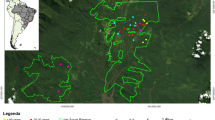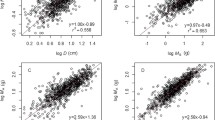Abstract
Tropical palms reach tree-like heights without a vascular cambium through sustained cell expansion and lignification of primary tissues, but only a fraction of palms have been explored in their allometric relationships. Here, our main question was to determine how palms depart from the traditional mechanical models developed for trees and how they approach the theoretical buckling limit. We analyzed the stem allometry of 1603 palms of 14 species from different strata at 10 sites in Costa Rica and Peru. We measured their fit to the stress, elastic, and geometric similarity models, and their position relative to the maximum theoretical buckling limit calculated for trees. We evaluated the slope of the linear and logarithmic regressions between stem diameter and height using logarithmic least squares, and standardized major axis regression (SMA), expecting segregation according to canopy position and geographic location. Seventeen out of 19 statistically significant models had SMA slopes > 1, and 11 had SMA slopes ≥ 2, departing from traditional mechanical models developed for trees. Many species varied their allometry relative to geographic location. Canopy palms showed the highest regression fit but had less steep slopes than understory and subcanopy species. Subcanopy and understory species were more underbuilt than canopy palms, increasing height faster than diameter. Some of the tallest canopy palms surpassed the maximum buckling limit whereas subcanopy and understory species were consistently below the buckling limit of record-size trees. Palm stem allometry changed in response to environmental conditions.


Similar content being viewed by others
References
Alvarez-Clare S, Mack MC, Brooks M (2013) A direct test of nitrogen and phosphorus limitation to net primary productivity in a lowland tropical wet forest. Ecology 94:1540–1551
Alves LF, Martins FR, Santos FAM (2004) Allometry of a neotropical palm, Euterpe edulis Mart. Acta Bot Bras 18:369–374
Andersen KM, Endara MJ, Turner BL, Dalling JW (2012) Trait-based community assembly of understorey palms along a soil nutrient gradient in a lower montane tropical forest. Oecologia 168:519–531
Avalos G, Otárola MF (2010) Allometry and stilt root structure of the neotropical palm Euterpe precatoria (Arecaceae) across sites and successional stages. Am J Bot 97:388–394
Avalos G, Sylvester O (2010) Allometric estimation of total leaf area in the neotropical palm Euterpe oleracea at La Selva, Costa Rica. Trees Struct Funct 24:969–974
Avalos G, Salazar D, Araya AL (2005) Stilt root structure in the neotropical palms Iriartea deltoidea and Socratea exorrhiza. Biotropica 37:44–53
Cambronero M, Avalos G, Alvarez-Vergnani C (2018) Variation in the carbon fraction of seven neotropical palm species of different forest strata. Palms 62:25–34
Clark DB, Clark DA (2000) Landscape-scale variation in forest structure and biomass in a tropical rain forest. For Ecol Manag 137:185–198
Claussen JW, Maycock CR (1995) Stem allometry in a North Queensland tropical rainforest. Biotropica 27:21–426
Condit R (1998) Tropical forest census plots: methods and results from Barro Colorado Island, Panama and a comparison with other plots. Springer, Berlin
Condit R, Engelbrecht BM, Pino D, Pérez R, Turner BL (2013) Species distributions in response to individual soil nutrients and seasonal drought across a community of tropical trees. Proc Natl Acad Sci USA 110:5064–5068
Costa FR, Guillaumet JL, Lima AP, Pereira OS (2009) Gradients within gradients: the mesoscale distribution patterns of palms in a central Amazonian forest. J Veg Sci 20:69–78
Da Silva F, Suwa R, Kajimoto T, Ishizuka M, Higuchi N, Kunert N (2015) Allometric equations for estimating biomass of Euterpe precatoria, the most abundant palm species in the Amazon. Forests 6:450–463
Dransfield J, Uhl NW, Asmussen CB, Baker WJ, Harley MM, Lewis CE (2008) Genera palmarum. Evolution and classification of the palms, 2nd edn. Royal Botanic Gardens, Kew
Eiserhardt WL, Svenning JC, Kissling WD, Balslev H (2011) Geographical ecology of the palms (Arecaceae): determinants of diversity and distributions across spatial scales. Ann Bot Lond 108:1391–1416
Feldpausch TR, Banin L, Phillips OL, Baker TR, Lewis SL, Quesada CA, Affum-Baffoe K et al (2011) Height-diameter allometry of tropical forest trees. Biogeosciences 8:1081–1106
Gatti MG, Campanello PI, Goldstein G (2011) Growth and leaf production in the tropical palm Euterpe edulis: light conditions versus developmental constraints. Flora 206:742–748
Goodman RC, Phillips OL, del Castillo Torres D, Freitas L, Cortese ST, Monteagudo A, Baker TR (2013) Amazon palm biomass and allometry. For Ecol Manag 310:994–1004
Grayum MH (2003) Arecaceae. In: Hammel BE, Grayum MH, Herrera C, Zamora N (eds) Manual de plantas de Costa Rica, vol III. Missouri Botanical Garden, St. Louis, pp 201–293
Henderson AJ (2011) A revision of Geonoma (Arecaceae). Phytotaxa 17:1–271
Kahn F, De Granville JJ (2012) Palms in forest ecosystems of Amazonia. Springer, Berlin
Killmann W (1983) Some physical properties of the coconut palm stem. Wood Sci Technol 17:167–185
King D (1981) Tree dimensions: maximizing the rate of height growth in dense stands. Oecologia 51:351–356
King DA (1996) Allometry and life history of tropical trees. J Trop Ecol 12:25–44
King DA (2011) Size-related changes in tree proportions and their potential influence on the course of height growth. In: Meinzer FC, Lachenbruch B, Dawson TE (eds) Size- and age-related changes in tree structure and function, vol IV. Springer, Dordrecht, pp 165–191
King DA, Davies SJ, Tan S, Nur Supardi M (2009) Trees approach gravitational limits to height in tall lowland forests of Malaysia. Funct Ecol 23:284–291
Kohyama T, Suzuki E, Partomihardjo T, Yamada T, Kubo T (2003) Tree species differentiation in growth, recruitment and allometry in relation to maximum height in a Bornean mixed dipterocarp forest. J Ecol 91:797–806
Legendre P (2014) lmodel2: model II regression. R package version 1.7-2
Lieberman M, Lieberman D, Vandermeer JH (1988) Age-size relationships and growth behavior of the palm Welfia georgii. Biotropica 20:270–273
McMahon TA (1973) Size and shape in biology. Science 179:1201–1204
McMahon TA, Kronauer RE (1976) Tree structures: deducing the principle of mechanical design. J Theor Biol 59:443–466
Niklas KJ (1993) The scaling of plant height: a comparison among major plant clades and anatomical grades. Ann Bot Lond 72:165–172
Niklas KJ (1994) Plant allometry: the scaling of form and process. University of Chicago, Chicago
Niklas KJ (1995) Size-dependent allometry of tree height, diameter and trunk-taper. Ann Bot Lond 75:217–227
Ninazunta M, Queenborough SA, Hernández C, Valencia R (2016) Growth strategies of the arborescent palm Iriartea deltoidea in a western Amazonian forest. Bot J Linn Soc 182:411–424
O’Brien ST, Hubbell SP, Spiro P, Condit R, Foster RB (1995) Diameter, height, crown, and age relationship in eight neotropical tree species. Ecology 76:1926–1939
Osunkoya OO, Omar-Ali K, Amit N, Dayan J, Daud DS, Sheng TK (2007) Comparative height–crown allometry and mechanical design in 22 tree species of Kuala Belalong rainforest, Brunei, Borneo. Am J Bot 94:1951–1962
Otárola MF, Avalos G (2014) Demographic variation across successional stages and their effects on the population dynamics of the neotropical palm Euterpe precatoria. Am J Bot 101:1023–1028
Poorter L, Bongers L, Bongers F (2006) Architecture of 54 moist-forest tree species: traits, trade-offs, and functional groups. Ecology 87:1289–1301
Quinn GP, Keough MJ (2002) Experimental design and data analysis for biologists. Cambridge University Press, Cambridge
Rich PM (1986) Mechanical architecture of arborescent rain forest palms. Palms 30:117–131
Rich PM (1987a) Developmental anatomy of the stem of Welfia georgii, Iriartea gigantea, and other arborescent palms: implications for mechanical support. Am J Bot 74:792–802
Rich PM (1987b) Mechanical structure of the stem of arborescent palms. Bot Gaz 148:42–50
Rich PM, Helenurm K, Kearns D, Morse SR, Palmer MW, Short L (1986) Height and stem diameter relationships for dicotyledonous trees and arborescent palms of Costa Rican tropical wet forest. Bull Torrey Bot Club 113:241–246
Schoute JC (1912) Über das dickenwachstum der palmen. Ann Jard Bot Buitenzorg 11:1–209
Silvertown J (2004) Plant coexistence and the niche. Trends Ecol Evol 19:605–611
Sposito TC, Santos FA (2001) Scaling of stem and crown in eight Cecropia (Cecropiaceae) species of Brazil. Am J Bot 88:939–949
Sterck F, Bongers F (1998) Ontogenetic changes in size, allometry, and mechanical design of tropical rain forest trees. Am J Bot 85:266
Svenning JC (2001) On the role of microenvironmental heterogeneity in the ecology and diversification of neotropical rain-forest palms (Arecaceae). Bot Rev 67:1–53
Sylvester O, Avalos G (2013) Influence of light conditions on the allometry and growth of the understorey palm Geonoma undata subsp. edulis (Arecaceae) of neotropical cloud forests. Am J Bot 100:2357–2363
Tomlinson PB (1979) Systematics and ecology of the Palmae. Annu Rev Ecol Syst 10:85–107
Tomlinson PB (1990) The structural biology of palms. Oxford University, New York
Tomlinson PB (2006) The uniqueness of palms. Bot J Linn Soc 151:5–14
Tomlinson PB, Huggett BA (2012) Cell longevity and sustained primary growth in palm stems. Am J Bot 99:1891–1902
Tomlinson PB, Horn JW, Fisher JB (2011) The anatomy of palms. Oxford University, New York
Waterhouse JT, Quinn CJ (1978) Growth patterns in the stem of the palm Archontophoenix cunninghamiana. Bot J Linn Soc 77:73–93
Acknowledgements
We thank the students and staff of The School for Field Studies for their help during field work, the staff of La Selva, Santa Elena, Tirimbina, El Rodeo, and Los Amigos for facilitating research at their field stations. Two anonymous reviewers provided key feedback that improved the original manuscript. This research was supported by the Directorate of Research of the University of Costa Rica Project number 111-A3-129, the International Palm Society, the Organization for Tropical Studies, Tirimbina Biological Reserve, IdeaWild, and The School for Field Studies. Alexandra Donahue corrected the final text.
Author information
Authors and Affiliations
Contributions
GA conceived, designed, implemented the study and wrote the manuscript. MG, LDR, MFO, MC, CAV, OS, and GR edited the ms and contributed data. GA analyzed the results.
Corresponding author
Additional information
Communicated by Fernando Valladares.
Rights and permissions
About this article
Cite this article
Avalos, G., Gei, M., Ríos, L.D. et al. Scaling of stem diameter and height allometry in 14 neotropical palm species of different forest strata. Oecologia 190, 757–767 (2019). https://doi.org/10.1007/s00442-019-04452-7
Received:
Accepted:
Published:
Issue Date:
DOI: https://doi.org/10.1007/s00442-019-04452-7




